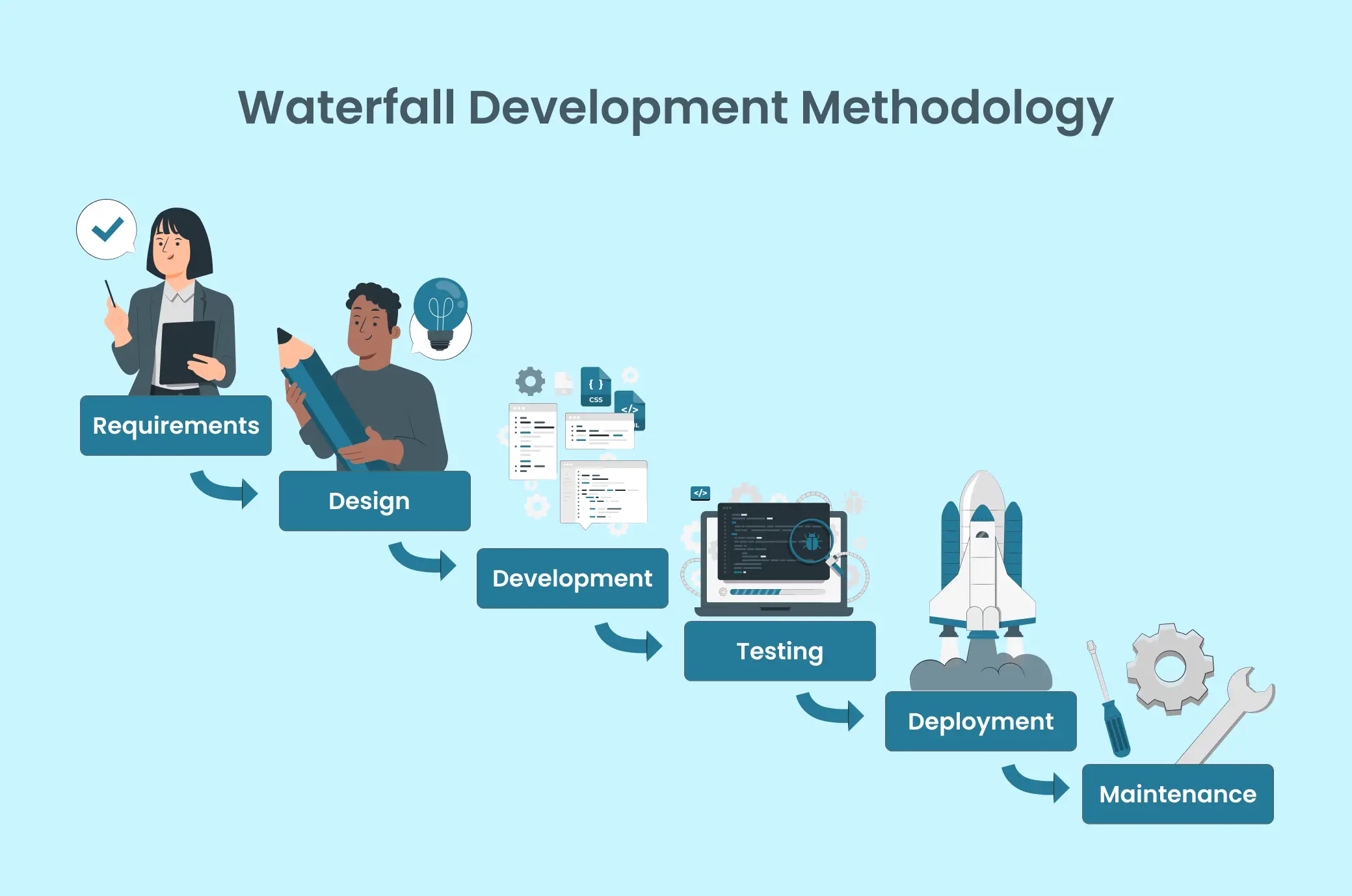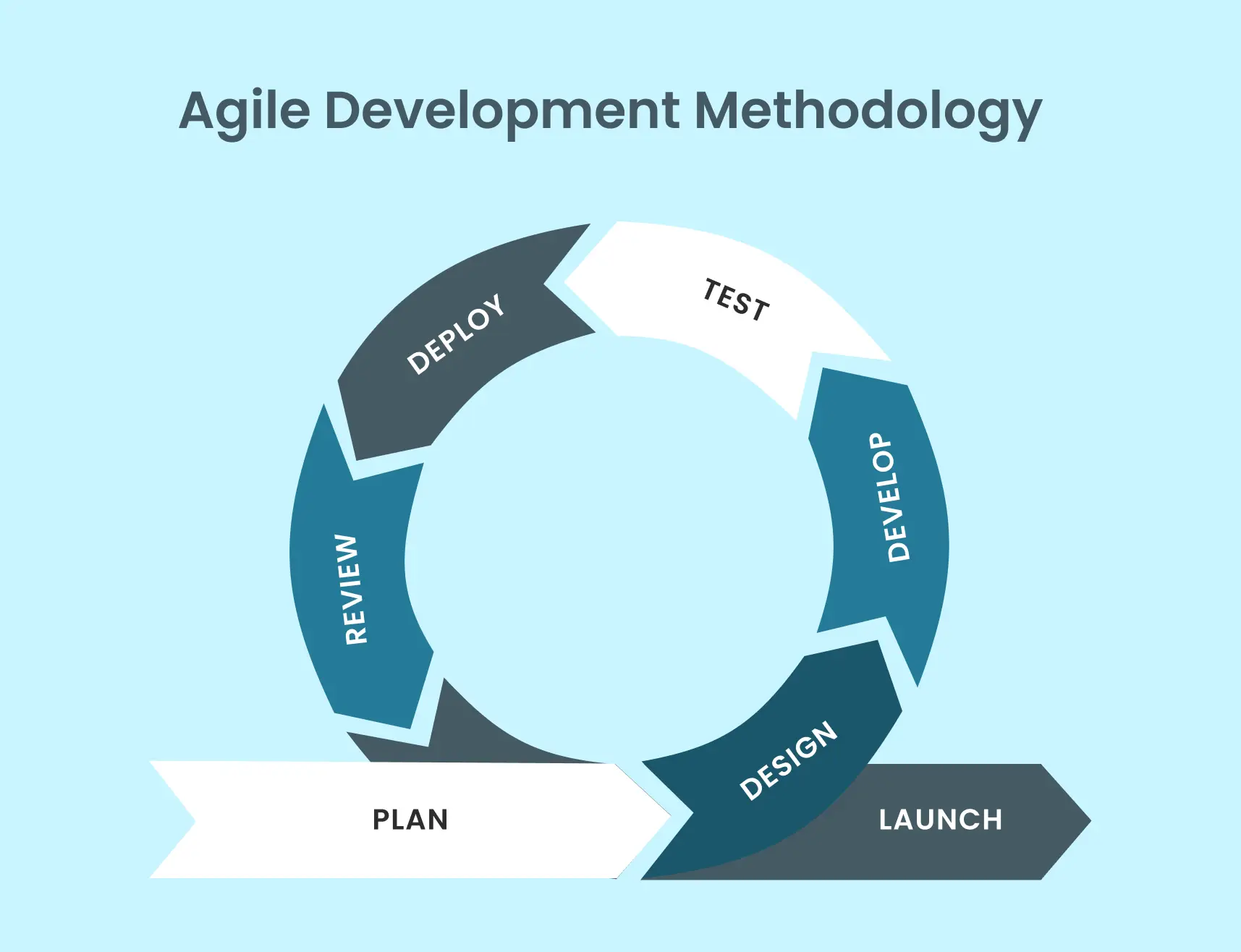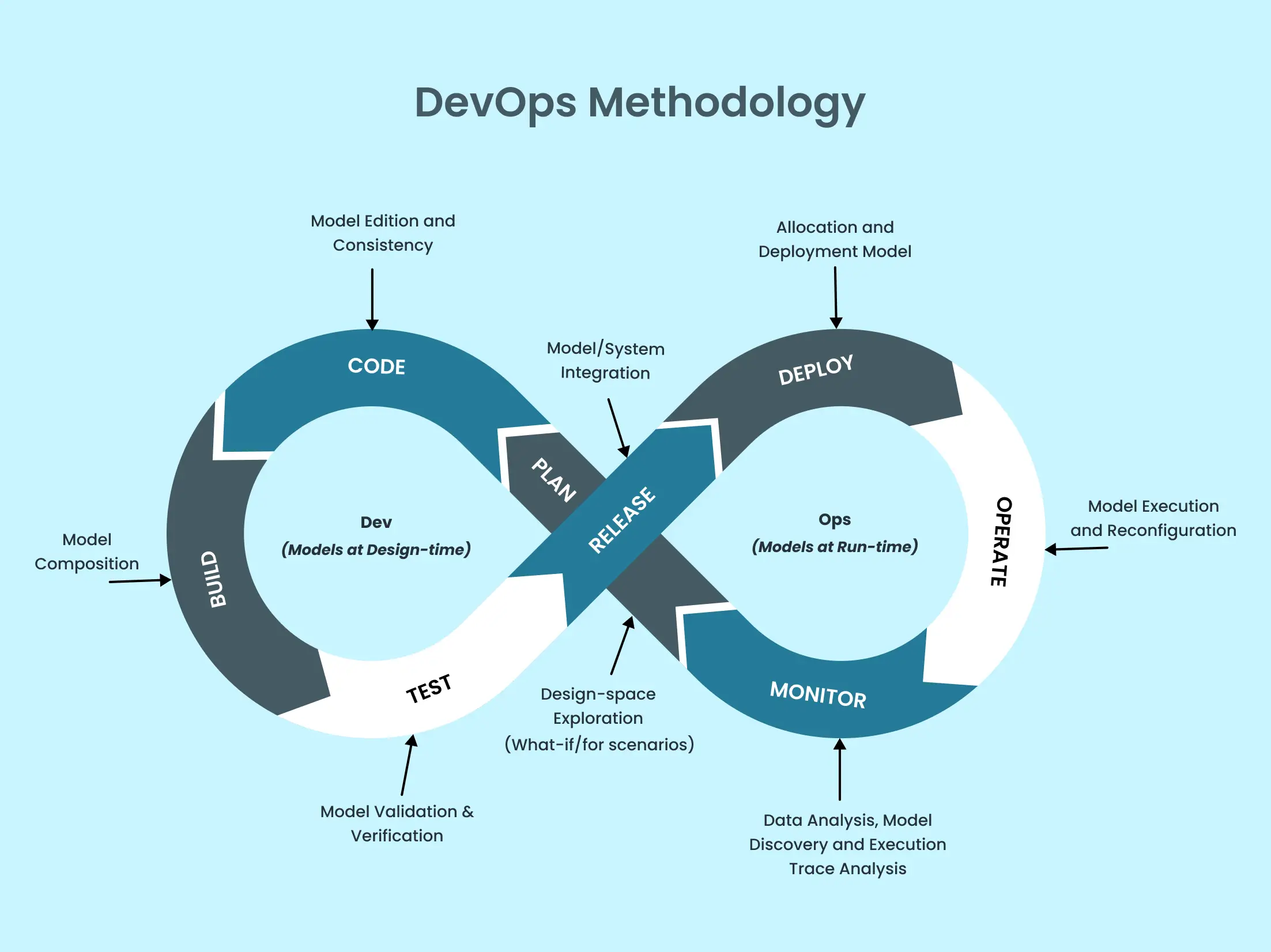Software development methodology can significantly impact a project's success by providing a clear roadmap for your software project, ensuring efficiency and quality. Following the appropriate development method aligning with your project goal also simplifies tasks, improves collaboration, and facilitates continuous improvements, helping you achieve the desired outcome on time.
There are many software development methodologies available and each has its own benefits and drawbacks.
So, which is the best software development methodology for your upcoming software project? It largely depends on your business goal, team strengths, and other factors.
In this blog, we will delve into the top software development methodologies to help you make an informed decision.
This Article Contains:
What is a Software Development Methodology?
A software development methodology is a process software developers follow to build software. It involves a series of steps, principles, and frameworks to organize tasks and utilize resources efficiently throughout the software development lifecycle to ensure they can complete the software project within a stipulated timeline.
Best Software Development Methodologies for 2024
Software development has evolved as businesses started to use more complex software that required adopting new methodologies to cater to the evolving market demands. Agile is a popular software development methodology example that has redefined the way software is developed.
However, some other methods are suitable for specific projects. Here is a list of software development methodologies that are popular today.
1. Waterfall Development Methodology
The Waterfall method is a traditional approach to completing a software project that involves a series of steps to be followed sequentially. The developers need to complete each step before moving to the next one.

From conceptualization to development and testing, this method requires comprehensive planning for every stage before initiating the development process. As the name suggests, making changes is not recommended once a stage is completed in this method. This makes the Waterfall methodology impractical for some projects.
| Pros | Cons |
|---|---|
|
|
Ideal For
It is the best choice for building software with well-defined project goals, costs, and timelines that can follow a linear and sequential approach.
2. Agile Development Methodology
Agile is the most used software development methodology that streamlines the development process. This method was developed to overcome the inflexibility of the waterfall and other highly structured methods. The agile development approach accommodates change at times during the development method, which makes it the best methodology for software development.
If you want to know more about the Agile Software Development Method, consider reading our blog, “Ultimate Guide to Agile Software Development”.

Agile is a highly adaptable approach that does not follow a hard and fast rule, rather it focuses on creating working software. In this method, the team is divided into small groups, working on short sprints or iterations of 2-4 weeks. During each sprint, teams complete a specific task and work towards delivering working software.
| Pros | Cons |
|---|---|
|
|
Ideal For
It is suitable for building high-quality and complex software with evolving requirements and requires iterative delivery of working software.
3. DevOps Methodology
DevOps is a software development methodology that emphasizes smooth collaboration between the development team (Dev) and the IT operation team (Ops). In traditional application development methods like Waterfall, these teams work independently, leading to inefficiencies in the software delivery process.

DevOps eliminates these issues, where both teams work together and share responsibility throughout development. This method automates repetitive tasks and promotes integration and delivery (CI/CD), shortening the development cycle and ensuring high-quality software.
| Pros | Cons |
|---|---|
|
|
Ideal For
It is a perfect choice to build highly scalable, secure software using microservices architecture that requires rapid development.
4. Extreme Programming Methodology
Extreme Programming (XP) is one of the top software development methodologies available now. It is based on the agile approach that focuses on continuous development and delivery of working software within a short time frame.
This software method emphasizes close collaboration between the development team and client, prioritizing their feedback and continuous improvement throughout the software development lifecycle.
The XP model utilizes iterative development and each iteration involves five phases i.e planning, designing, development, testing and implementing the client's feedback. The main aim of this method is to cut non-essential elements and create functional software as soon as possible.
| Pros | Cons |
|---|---|
|
|
Ideal For
It is a great choice for building cost-effective yet high-quality software in a shorter time compared to other methods.
5. Lean Development
The lean software development method is based on Japanese lean manufacturing principles that focus on minimizing wastage and increasing productivity. The workflow in lean methodology eliminates activities like excessive planning documentation and unnecessary features that don't add value to the final product.
Lean development facilitates building high-quality and cost-effective software, making it relevant for businesses looking to optimize their development processes and create an impactful application.
| Pros | Cons |
|---|---|
|
|
Ideal For
It is an ideal methodology for building a cost-effective solution in a shorter time.
6. Prototype Methodology
This is a popular application development method that involves creating a basic and functional version of your software.
By involving the stakeholders in the prototyping process, the development teams can gain valuable insights and refine the design and features accordingly. This ensures the final product aligns with the business requirements and meets the users' needs.
| Pros | Cons |
|---|---|
|
|
Ideal For
This development method offers a better solution for projects with a higher degree of risks and uncertainty.
7. Rapid Application Development
As the name suggests, the Rapid Application Development (RAD) methodology focuses more on core activities such as modeling, prototyping, developing, and testing and less on planning. This enables developers to quickly deliver a functional product to clients, making it one of the top software development methodologies.
RAD leverages pre-built components and code libraries to expedite the development process. The process also allows quick feedback loops, enabling teams to adapt to changing business requirements, making it one of the most popular software development methodologies.
| Pros | Cons |
|---|---|
|
|
Ideal For
This is an ideal methodology if you are looking for faster time-to-market and a cost-effective solution.
8. Scrum Development Methodology
Scrum is one of the top software development methodologies available. Based on the Agile development principles, Scrum involves breaking down a software project into small parts called "Sprints." Daily stand-up meetings are conducted during the sprints to discuss progress and address any obstacles.
At the end of each sprint, the development team demonstrates the completed work to stakeholders and implements their feedback to reflect on what went well and identify the areas for improvement. This ensures the end product meets the client's requirements.
| Pros | Cons |
|---|---|
|
|
Ideal For
It is suitable for software projects with evolving requirements.
9. Feature-Driven Development
Feature-driven development is an iterative and incremental development method that focuses on developing features to satisfy the customers' needs.
The development team breaks down the tasks into a list of features to be developed. Each feature goes through short development cycles, including designing, development, and testing with clear deliverables at the end.
| Pros | Cons |
|---|---|
|
|
Ideal For
It is suitable for a large team working on a complex project with well-defined features.
10. Dynamic Systems Development Method
Dynamic Systems Development Method (DSDM) is another most common software development methodology and is based on the RAD process. This method prioritizes developing software that directly addresses business requirements and delivers tangible value.
DSDM typically involves five major iterative phases i.e. Feasibility & Business study, Functional Model, Design & Build, and Implementation. It strictly adheres to deadlines and emphasizes active user involvement for continuous improvement throughout the software development life cycle.
| Pros | Cons |
|---|---|
|
|
Ideal For
This method is perfect for projects with changing requirements and the involvement of users in the development process.
11. Spiral Development Method
The spiral development method emphasizes more on mitigating risk. It is one of the top software development methodologies that combines the iterative development process with the elements of the Waterfall process. Like most other methods, Spiral also involves several phases i.e. Planning, Risk Analysis, Development, and Evaluation.
With an iterative approach, the development team can quickly address potential risks and make necessary changes, resulting in robust and efficient software that aligns with the business requirements.
| Pros | Cons |
|---|---|
|
|
Ideal For
It is suitable for high-risk and highly customized projects where business requirements can change significantly.
5 Factors to Consider When Choosing the Software Development Methodology for Your Software Project
Software development involves significant investments and choosing the right software development methodology is crucial for the software project's success. Let's look at the top factors you need to consider when choosing the most common software development methodology for your software project.
1. Your Project Scope
Every software is built to solve some business problems. It should perform some specific tasks. When you wish to develop software, you need to have a clear idea of the project scope including what you want to achieve, the complexity, timelines, and how much user involvement is required.
For example, the Waterfall method is the most common software development methodology for smaller and well-defined projects, while Agile, XP, and Scrum are good for projects with evolving requirements.
2. Evaluate Team Expertise & Preference
This is another crucial factor to consider before choosing a development approach. Although most developers are aware of the top software development methodologies, evaluating your team's expertise and preference is crucial.
Choose a software development methodology that aligns with your team's preferences and skills. For instance, the Waterfall or DSDM approach fits better with the team that prefers a more structured method.
3. Determine Flexibility & Scalability Needs
In today's dynamic business environment, the scope of software may change quickly. If you are looking to build a large and complex application, you may like to add or remove some features during the development process.
The most popular software development methodologies like Agile and extreme programming allow you to make changes anytime during the development.
4. Consider Time & Budget
While developing software, you should assess the project's time and budget to ensure you get maximum ROI from it. If you want faster time to market, Rapid Application Development or Feature-Driven Development can be the best software development methodologies for your project as they allow quick and cost-effective application development.
5. Seek Expert Guidance
Choosing the best software development methodology is not an easy task if you do not come from a software development background. Moreover, some of the top software development methodologies are similar making it difficult to choose the most suitable one for your software project.
What are the Challenges involved in Implementing the Software Development Methodologies?
Using the right software development methodology offers numerous benefits for businesses, such as improved efficiency, better collaboration, and high-quality software. However, there are some challenges involved in implementing the most popular software development methodologies. They are:
1. Resistance to Change
It is one of the most significant challenges in adopting a new software development methodology. The team members may be accustomed to and comfortable with a particular methodology and may resist the change as it requires a mindset shift and adjustment to established processes.
2. Lack of Expertise
Implementing a new software development methodology requires a deep understanding of its principles, processes, and workflow. Without the right knowledge, it will be challenging to follow the process and may lead to misinterpretations and project failure.
3. Project Size
Choosing the right software development methodology also depends on the project size. A large project may require developers to select a flexible methodology like Agile, which can be the best option.
4. Customization
Every software project is unique and a particular development methodology may not be the right fit for all projects. Your team may need to adjust it to align with the project's requirements.
5. Communication & Collaboration
Effective communication and collaboration within cross-functional teams are crucial for developing a software project successfully. This can be a challenge in choosing the best software development methodology for your software project.
6. Expenditure on New Tools and Technologies
Adopting a new methodology may require additional tools and technologies, which may require more investment. Moreover, the development team may also need training to incorporate it.
7. Risk Management
Selecting the appropriate development methodology mitigates the risk but implementing a new method can bring new risks including missed deadlines, quality issues, or more budget. These risks need to be addressed to ensure project success.
Wrapping Up
Building software involves a considerable investment, making it essential for businesses to follow the right process to reduce the risks of failure and ensure timely delivery. The top 11 software development methodologies we have discussed are the most commonly used these days.
Each of these methodologies has its benefits and drawbacks. Based on the project goal, requirements, and budget, you can choose a methodology best suited for your software project.
If you are unable to decide which software development methodology to use for your next software project, Mayura Consultancy Services can help you out. Our developers have decades of experience in building robust, scalable, and secure software. Book a consultation with us to discuss your software project and we can guide you with the right methodology aligned with your business needs.
Frequently Asked Questions
The most popular software development methodologies include Agile, Waterfall, Extreme programming, Rapid Application Development, Scrum, and others. You can choose the software development methodology by carefully considering your software project requirements.
Agile, Scrum, and extreme programming allow continuous improvement post-launch and are suitable for software projects with changing requirements.






